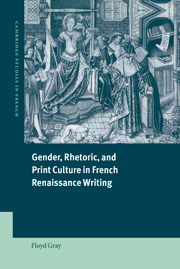Introduction
Published online by Cambridge University Press: 22 September 2009
Summary
One of the principal themes running through this study is that of the implications of the use of rhetorical strategies in the articulation of marginal discourses. The question variously raised is to what extent and in what ways the peculiar expression of the place and presence of women, sexual difference, auctorial identity, is a reflection of literary rather than social reality. Another, corollary theme is that of the contribution of print and printers to the shape of vernacular writing and the subjects it privileges.
The gradual acceptance of French as a language of literature and science is mirrored in the printing of French, regularly by the middle of the sixteenth century, in the roman and italic formerly reserved for Latin texts. Printing and the printing trade redefined in profound ways the context of editor–author and author–reader interaction, encouraging the introduction and exploitation of commercially motivated materials and techniques, while compounding the problem of how and what to read. Given the formal rhetorical training Renaissance writers and readers alike received, and the fact that rhetoric is essentially the means by which writers contrive to rival with and reorganize reality, it is hardly surprising that topical and linguistic play is one of the factors at work in the literature of the day, or that the reading public was adequately prepared to anticipate and appreciate both its performative and its provisional qualities.
- Type
- Chapter
- Information
- Publisher: Cambridge University PressPrint publication year: 2000

